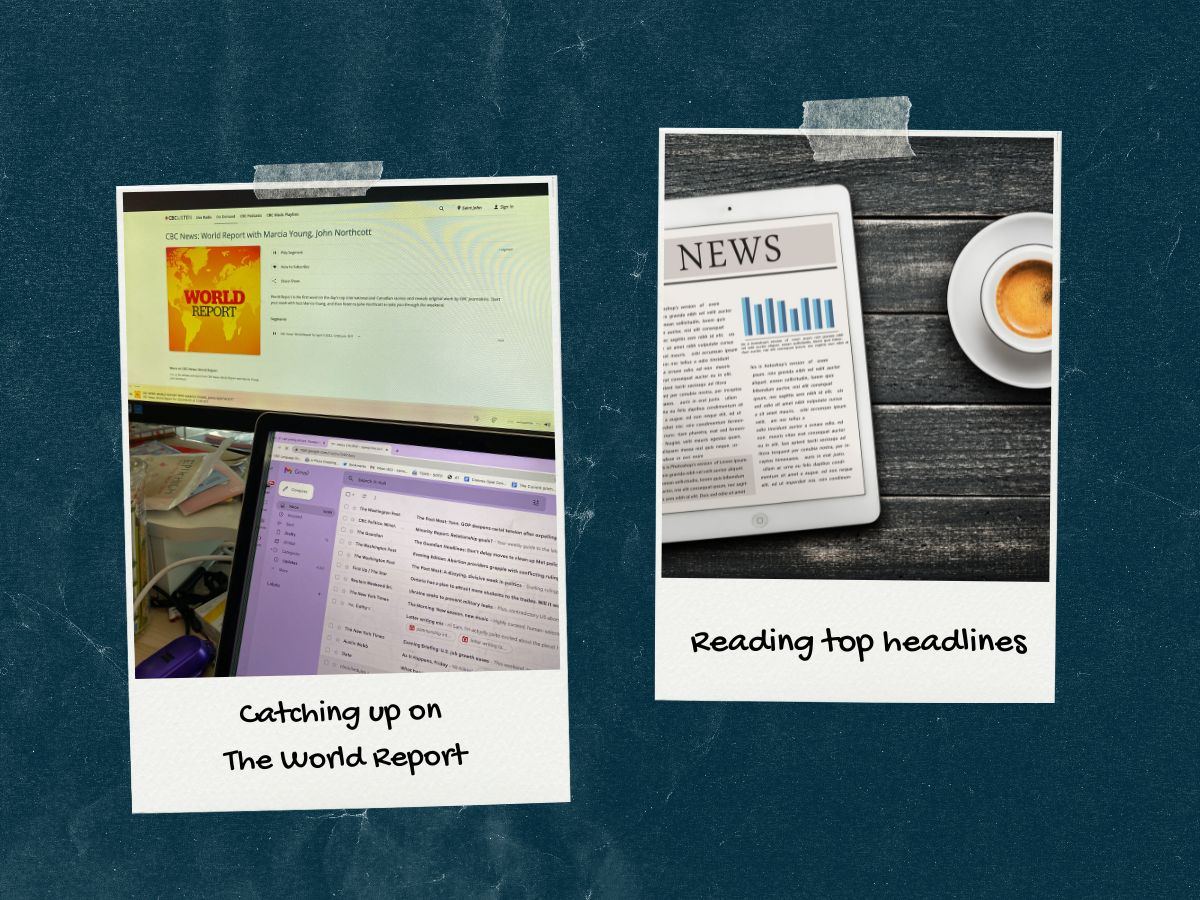Radio producer: Samantha Lui: Honing pitches
Samantha Lui, ‘14, is an associate producer for CBC Radio, currently working at The Current (external link) . Before that, she worked as a chase producer for CBC Toronto’s Metro Morning (external link) . She’s contributed to other shows such as As It Happens (external link) and Cross Country Checkup (external link) , Now or Never, World Report, Day 6 and The Doc Project.
For the latter, she was part of a team that won Gold at the New York Festivals Radio Awards for Best Coverage Of Ongoing News Story.

(Photo courtesy of Samantha Lui’s Twitter)
7:00 a.m.: Wake up

Illustration by Dania Ali (photo courtesy of Samantha Lui and Canva)
When I wake up in the morning, I immediately start listening to the news, just to see what the top daily headlines and stories are. There are a few different sources I go to for the news, including CBC News: The World Report (external link) , and a bunch of newsletters that I subscribe to. I scroll through my email inbox to see if any of the sources responded overnight to my interview requests.
8:30 a.m.: Pitches

Illustration by Dania Ali (photo courtesy of Samantha Lui and Canva)
This is when I go to my computer and start writing out the type of pitches that I will bring into the morning story meeting, which usually starts at around 9:30 a.m. For example, I was working on a story recently about the Silicon Valley Bank collapse (external link) , and I had to come up with a treatment for it. For my pitch I had to think of what kind of guests we would book, perhaps someone who was using the bank as a client in Canada. Then, I would need an interviewee who could give us a bigger picture, look at what exactly is happening and the impact, like a reporter or an expert in tech and startups.
9:30 a.m.: Story Meeting 1

Illustration by Dania Ali (photo courtesy of Canva)
Our story meetings usually take place virtually and this is where we meet up in something called pods, which is usually groups of three producers. Here is where we pitch our story ideas and brainstorm treatments around how we could put together the show. Other local shows are a bit different: they usually would pitch guests and do seven minute interviews, but at The Current we come out with a whole roll out, which is basically describing what the story is (confirming guests, focus statements, additional audio and tape being used, etc.). We take the best two story ideas (sometimes three) out of this meeting, into the next one.
10:00 a.m.: Story Meeting 2

Illustration by Dania Ali (photo courtesy of Canva)
These meetings take place in pods and there are usually two per day, led by pod leaders who we bring our story pitches to. There’s one called ‘Pod A’ which is focused on lead stories that need a short turn around (e.g. what is in the headlines). For more feature-style story pitches we use ‘Pod B’, where you can get a little more time to work on them. Some stories overlap between the pods as well. Pod leaders will take the pitches to senior producers, who will make the final call. There can be some pushback during this process, where they may want to question your pitch more to understand the story and get a clearer picture of what it would look like on the show the next morning.
10:30 a.m.: Break-time

Illustration by Dania Ali (photo courtesy of Canva)
At this point, the producers take a small break while the senior team decides what is going to be on the news agenda and finalize story assignments.
11:00 a.m.: Assignment notes

Illustration by Dania Ali (photo courtesy of Samantha Lui and Canva)
One of the three senior producers will tell you what is going to be on the show for the next day, so you can start working on your story. There will be a lead story, and that can change from day-to-day. We populate the show with panels, interviews, documentaries or a simple one-off. An example of a one-off would be this story I worked on recently about the internet shutdown in the Punjab state (external link) , for which I booked a reporter from Reuters to give us the lay of the land, explain why this is happening.
12:00 a.m.: Working on my stories

Illustration by Dania Ali (photo courtesy of Samantha Lui and Canva)
The rest of the day is spent chasing some upcoming stories in the next week. Sometimes, we do segments for the next day and will be working collaboratively with other producers to put a story together. This is when I book guests, collect tape from online to compliment the story and start writing up the script for the host.
4:00 p.m.: File stories

Illustration by Dania Ali (photo courtesy of Canva)
I try to get everything in by 4 p.m., as the show goes on air the next day (to the eastern provinces) when it is 8:00 a.m. EDT. To fill out the segment, we write a question line for the guest, cut tape and audio to set up the segment and provide any background articles and information for our host to help him prepare.
5:00 p.m.: End of work day

Illustration by Dania Ali (photo courtesy of Canva)
My work day usually ends here. I either go home or walk to the climbing gym to unwind. Before bed, I will save some news articles to read to get my mind ready for the next day.
This interview has been edited for length and clarity.
